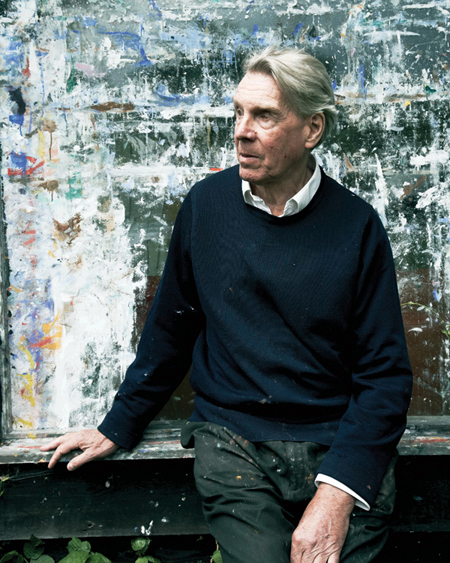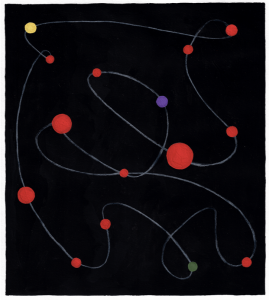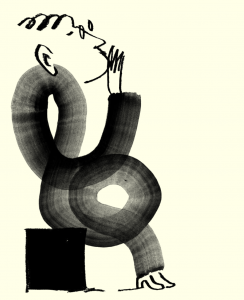 As a young man, Sargy Mann was a keen sportsman, drummed in a jazz band with Dudley Moore, and played a mean game of chess – even when blindfolded. But it was as a painter that he made his name. Diagnosed with cataracts at the age of 36, he eventually lost his sight completely, but as he explains to Laura Barber, he has always been interested in different ways of seeing
As a young man, Sargy Mann was a keen sportsman, drummed in a jazz band with Dudley Moore, and played a mean game of chess – even when blindfolded. But it was as a painter that he made his name. Diagnosed with cataracts at the age of 36, he eventually lost his sight completely, but as he explains to Laura Barber, he has always been interested in different ways of seeing
Growing up, my sister was the artistic one. My great passion was sport and I wanted to be a professional footballer or cricketer. The school we went to was very liberal – the kind of place where you didn’t have to go to lessons – and I barely spent any time in the art room. Though I remember once wanting to draw a man chopping down a tree: I stood in front of my mother’s full-length mirror and swung a walking stick so I could get the action right. It was the first time I’d ever drawn directly from nature, and tried to understand something by really looking hard.
I left school at 16 and was apprenticed to Morris Radiators in Oxford to become an engineer. After my somewhat unworldly childhood, the world of the factory was totally mysterious to me. I was a terribly self-conscious boy, and rather scared of people. But I began to develop a bit of an arty personality. I loved jazz and had a big record collection; I used to go to the university jazz club and even played in the university band when they needed a drummer. I’d occasionally draw the musicians and dancers too, but I didn’t begin taking my art seriously until I moved to London.
“I was always trying to use my art to see more deeply, to be more involved in the world”
I’d decided I wanted to read for a maths degree, but I needed to have A-levels so I enrolled at Hammersmith Poly. Instead of attending lectures I’d go to the Natural History Museum and draw. I met an art student there and one evening, he came back to my flat where my drawings were all over the walls. He said I ought to be at art school and, in that instant, I realised that was what I wanted, more than anything else in the world, I’d just never admitted it to myself. He helped me prepare a portfolio and I managed to get into Camberwell. I had some wonderfully inspiring teachers there – Frank Auerbach, Euan Uglow, Dick Lee and Anthony Eyton – who very much believed that, right from the first day, you weren’t learning the craft of art, you were already doing the real thing.
In the late 60s, the idea that you’d leave art school and find a gallery was laughable. You had to earn your crust somehow, and I was lucky enough to do it by teaching at Camberwell and the Camden Arts Centre. My first sales of paintings all came about through my friendship with Elizabeth Jane Howard, who was married to Kingsley Amis and knew lots of interesting people. So from fairly early on, my paintings were being bought by people like John Betjeman and Iris Murdoch.My really big break came in 1987, when the dealer Christopher Burness saw some of my work and, amazingly, gave me a whole show. Suddenly, my paintings were selling at fantastically higher prices than I’d been charging and I was able to give up teaching – which, because of my deteriorating eyesight, was getting to be a bit ridiculous anyway. I once turned up late to a life drawing class and failed to spot the model standing nude about 12 feet in front of me.
All through the 80s, I was having eye operations and each time I came out of hospital, I was seeing differently, so I had to keep rediscovering what the world looked like and how to engage with it. Actually, I liked this because the great thing for an artist is not to repeat yourself. I was always trying to use my art to see more deeply, to be more involved in the world. And, even after I became blind, this didn’t change. I had to invent new methods of working – I mark certain points on the canvas with Blu-Tack, so I know where I am – but I’m still trying to capture the experience of the external world, and I can still move freely in it, through the imagination. Looking back, I don’t think I’d have liked the life of a professional sportsman, not nearly as much as I’ve liked being an artist. And the amazing thing is that I’m still able to do it today.




